Crawling From the Wreckage: Grant Morrison’s Doom Patrol
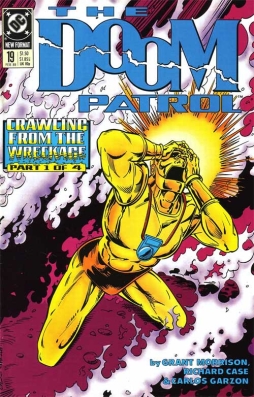 Grant Morrison’s Doom Patrol needs no context to be enjoyed; it is its own strange, powerful creature. But describing the context of the thing helps to throw into relief the accomplishment of the work. And for those who may not know the comic, explaining what it came out of may help to explain what it is itself.
Grant Morrison’s Doom Patrol needs no context to be enjoyed; it is its own strange, powerful creature. But describing the context of the thing helps to throw into relief the accomplishment of the work. And for those who may not know the comic, explaining what it came out of may help to explain what it is itself.
The Doom Patrol was a group of characters created for DC Comics in the early 60s, as the Silver Age of comics was getting underway; their first appearance, in My Greatest Adventure #80, hit the stands just before the first issue of Marvel’s X-Men. The two groups were famously similar: both were led by wheelchair-bound geniuses, and more significantly, both were a little stranger, a little darker, than other supergroups. The Patrol consisted of the Chief, the aforementioned scientific genius; Cliff Steele, AKA Robotman, whose brain had been transplanted into a metal body following a terrible accident; Negative Man, or Larry Trainor, a pilot wrapped in bandages who controlled a strange black ‘negative spirit’; and Elasti-Girl, Rita Farr, who could increase or decrease her size tremendously. Besides the similarity to the X-Men, the group vaguely resembled another Marvel team: the scientist leader, the orange-hued strongman (Robotman), the flying energy-controller (Negative Man), the woman who could disappear (by shrinking out of sight).
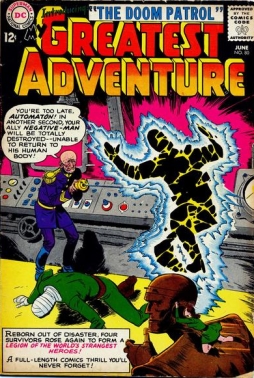 DC books tended to be less frenetic than Marvel in the Silver Age, better plotted, more straight-faced, but goofier, and with less memorable characters. I think the original Doom Patrol run fits the mold. It’s well-regarded by many for writer Arnold Drake’s tonally odd scripts, and especially for artist Bruno Premiani’s well-rendered strangeness. But these things are relative; the Patrol was still mostly a traditional super-team, fighting villains like the undying General Immortus, or groups like The Brotherhood of Evil. The tonal distinction was real, but subtle if you didn’t know comics. It was unusual to see a hero like Robotman pull one of his own limbs to use as a club. Unusual, even for Silver Age DC, to see a villain group like the Brotherhood led by creatures such as The Brain and Monsieur Mallah — a disembodied brain and a super-intelligent gorilla.
DC books tended to be less frenetic than Marvel in the Silver Age, better plotted, more straight-faced, but goofier, and with less memorable characters. I think the original Doom Patrol run fits the mold. It’s well-regarded by many for writer Arnold Drake’s tonally odd scripts, and especially for artist Bruno Premiani’s well-rendered strangeness. But these things are relative; the Patrol was still mostly a traditional super-team, fighting villains like the undying General Immortus, or groups like The Brotherhood of Evil. The tonal distinction was real, but subtle if you didn’t know comics. It was unusual to see a hero like Robotman pull one of his own limbs to use as a club. Unusual, even for Silver Age DC, to see a villain group like the Brotherhood led by creatures such as The Brain and Monsieur Mallah — a disembodied brain and a super-intelligent gorilla.
But the whole thing was played straight, with minimal humour or self-awareness. It was strange, but also a bit dull; Premiani’s storytelling was competent, but a little stiff, and his design sense didn’t seem particularly well-suited to either super-heroes or strangeness. As the book went on, it came to seem more and more like a bad knock-off of a Marvel book; the heroes squabbled with each other, and the narration tried unsuccessfully to capture the looseness of Stan Lee’s wiseass voice. The stories grew goofier, and more forced. Finally the series ended with the Patrol sacrificing themselves, letting themselves be blown up to save a small town in Maine.
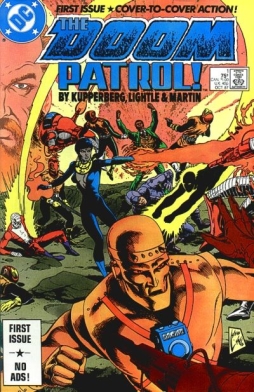 In mainstream comics, no idea, good or bad, remains dead for long. About ten years later writer Paul Kupperberg and artist Joe Staton introduced a new Doom Patrol in DC’s Showcase comic; a resurrected Robotman joined a new Negative Woman, a man named Joshua Clay who had taken the heroic identity of Tempest, and an Indian woman named Celsius who claimed to be the wife of the Doom Patrol’s former Chief. It didn’t last, but Kupperberg brought the group back every so often in other comics he wrote over the years, Robotman turned up in the highly-successful Marv Wolfman/George Pérez New Teen Titans series, and finally in the late 80s the group got another series of their own, scripted by Kupperberg, with slick art by Steve Lightle; after five issues, Lightle was replaced by Erik Larsen. While it introduced some new characters, including the magnetically-powered Rhea Jones, and a strange ape-like girl named Dorothy Spinner who could manipulate reality, the book was ultimately a mediocre mainstream super-hero title — neither especially good nor particularly strange. There was nothing remarkable about it at all.
In mainstream comics, no idea, good or bad, remains dead for long. About ten years later writer Paul Kupperberg and artist Joe Staton introduced a new Doom Patrol in DC’s Showcase comic; a resurrected Robotman joined a new Negative Woman, a man named Joshua Clay who had taken the heroic identity of Tempest, and an Indian woman named Celsius who claimed to be the wife of the Doom Patrol’s former Chief. It didn’t last, but Kupperberg brought the group back every so often in other comics he wrote over the years, Robotman turned up in the highly-successful Marv Wolfman/George Pérez New Teen Titans series, and finally in the late 80s the group got another series of their own, scripted by Kupperberg, with slick art by Steve Lightle; after five issues, Lightle was replaced by Erik Larsen. While it introduced some new characters, including the magnetically-powered Rhea Jones, and a strange ape-like girl named Dorothy Spinner who could manipulate reality, the book was ultimately a mediocre mainstream super-hero title — neither especially good nor particularly strange. There was nothing remarkable about it at all.
Until, in 1989, with issue 19 of the book, the title got a whole new creative team.
In the early 80s, DC had found some talented comics creators in England, among them artist Brian Bolland, and, most notably, writer Alan Moore, who redefined what could be done in a mainstream comic book with his run on Swamp Thing. DC hired a second wave of British talent in the late 80s: Jamie Delano fused horror with a political sensibility in Hellblazer, which starred Moore’s creation, punk occultist John Constantine; Peter Milligan reinvented the old Steve Ditko character Shade, the Changing Man; Neil Gaiman created a new mythology for his book Sandman. And a few issues before the first issue of Sandman appeared, a Scotsman named Grant Morrison began reinventing a previously-obscure hero called Animal Man, fusing an interest in animal rights with chaos theory, fractal story structure, and metafiction. It was Morrison who took on the Doom Patrol, and did amazing things with them.
These British writers seemed to have a broader cultural awareness than most American comics pros of the time; or at least they were less shy about bringing those influences into comics. You found a breadth of references in those writers, ranging from movements in poetry and art to the counter-culture of the day. You also found a use of language that was different from the traditions of American mainstream comics. These writers produced tight, precise scripts, with minimal reliance on thought balloons or even caption boxes. Dialogue was more vivid, less melodramatic. Conventions of the genre, the way things had always been done, were quietly discarded.
 So it was in Morrison’s Doom Patrol. But not content to question the conventions of super-hero narration, he went further, fusing traditional super-team adventure with something altogether stranger. The first adventures of his Patrol began quietly enough; Cliff Steele met a woman named Crazy Jane, who had 64 personalities, each of them with a different super-power, while Larry Trainor was fused with a female doctor by his Negative Spirit to create a hermaphroditic being called Rebis. Steele, Jane, and Rebis became the new Doom Patrol, investigating mysteries such as the city of Orqwith (a philosophical construction written into existence by a group of philosophers, “a city of glass labyrinths and observatories made of bone” attempting to extrude itself into this world to remake it in the image of that fantastic Borgesian place; the Patrol had to force it to confront its own unreality, thus dissolving it), a nigh-omnipotent being called Red Jack (trapped in an infinite house, powered by the pain of thousands of butterflies pinned to a wall, Jack claimed not only to be the Ripper of that name but also a gnostic God who had been imprisoned for the crime of creating gross matter), and Mister Nobody and the Brotherhood of Dada (a twist on the Doom Patrol’s old enemies The Brotherhood of Evil, this organisation included Sleepwalk, who only had super-powers when she was asleep, and the Quiz, a germ-phobic Japanese woman who had every super-power you didn’t think of).
So it was in Morrison’s Doom Patrol. But not content to question the conventions of super-hero narration, he went further, fusing traditional super-team adventure with something altogether stranger. The first adventures of his Patrol began quietly enough; Cliff Steele met a woman named Crazy Jane, who had 64 personalities, each of them with a different super-power, while Larry Trainor was fused with a female doctor by his Negative Spirit to create a hermaphroditic being called Rebis. Steele, Jane, and Rebis became the new Doom Patrol, investigating mysteries such as the city of Orqwith (a philosophical construction written into existence by a group of philosophers, “a city of glass labyrinths and observatories made of bone” attempting to extrude itself into this world to remake it in the image of that fantastic Borgesian place; the Patrol had to force it to confront its own unreality, thus dissolving it), a nigh-omnipotent being called Red Jack (trapped in an infinite house, powered by the pain of thousands of butterflies pinned to a wall, Jack claimed not only to be the Ripper of that name but also a gnostic God who had been imprisoned for the crime of creating gross matter), and Mister Nobody and the Brotherhood of Dada (a twist on the Doom Patrol’s old enemies The Brotherhood of Evil, this organisation included Sleepwalk, who only had super-powers when she was asleep, and the Quiz, a germ-phobic Japanese woman who had every super-power you didn’t think of).
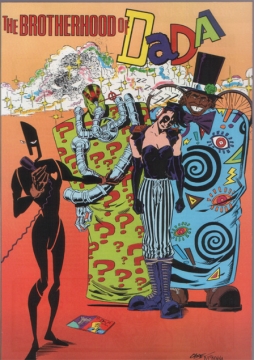 But things only got stranger from there. The Doom Patrol found themselves trying, not entirely successfully, to stop the horrific agents of the Cult of the Unwritten Book, who were trying to summon the Unmaker to destroy the universe; then went out into space, to deal with an ages-long war of civilizations over a cutting from the Tree of Knowledge. Oh, and Monsieur Mallah and the Brain returned, declared their love for each other, and were blown up by a malfunctioning robot body intended for Cliff Steele but which had developed sentience of its own — the whole story being an investigation into Cartesian notions of the duality of mind and body. And then there was Danny the Street, a sentient transvestite avenue that could move from city to city as it liked; Flex Mentallo, the Hero of the Beach; Mister Nobody’s tragic Presidential candidacy; the men from N.O.W.H.E.R.E.; and the terrifying question “why is the Pentagon the shape it is?” — really, you hardly know where to stop with this book.
But things only got stranger from there. The Doom Patrol found themselves trying, not entirely successfully, to stop the horrific agents of the Cult of the Unwritten Book, who were trying to summon the Unmaker to destroy the universe; then went out into space, to deal with an ages-long war of civilizations over a cutting from the Tree of Knowledge. Oh, and Monsieur Mallah and the Brain returned, declared their love for each other, and were blown up by a malfunctioning robot body intended for Cliff Steele but which had developed sentience of its own — the whole story being an investigation into Cartesian notions of the duality of mind and body. And then there was Danny the Street, a sentient transvestite avenue that could move from city to city as it liked; Flex Mentallo, the Hero of the Beach; Mister Nobody’s tragic Presidential candidacy; the men from N.O.W.H.E.R.E.; and the terrifying question “why is the Pentagon the shape it is?” — really, you hardly know where to stop with this book.
At the same time, plot descriptions only scratch the surface of the oddity. Morrison used all sorts of devices to keep his readers off-balance, to keep the book constantly changing and unpredictable. Automatic writing; cut-ups; characters who spoke only in anagrams; captions filled with imagery barely related to the panels around them. Consider, for example, the following character introduction, from the first page of issue 47:
Truth is inadequate at the best of times, but even more so when it comes to describing the Shadowy Mr. Evans. He can only be comprehended as the subject of a complex system of claim and counterclaim, rumor and denial. Some insist that he is, in fact, the first Adversary, the slinking Snake of Genesis, the true Serpent of Eden and the Tempter of Man. Others, while accepting this loony nonsense, add that the Serpent must be understood as the bringer of knowledge. The Serpent, which sheds its skin, is the symbol of life and rebirth. Sperm-serpent packed with DNA species-intelligence, who struggles with the repressive God of matter, Samael/Ialdabaoth/JHVH. Others refuse to acknowledge the existence of the Shadowy Mr. Evans, but they still cannot explain their vague dread of the words “kneecap,” “singlehanded,” “sheet music,” and “lottery,” for these are the words of power by which the shadowy Mr. Evans can be summoned.
Nevertheless, the Shadowy Mr. Evans is real. Lord of Meaningless Mottoes, sworn enemy of the Grand Old Dukes of Nothing in Particular, he dwells at length in his dreamy Library of Dust. Spiralling through the frayed edges of adolescent daydreams in darkened rooms, his house is a torture chamber filled with potpourri and spidery lace. Writing lovesongs for jangling guitars in the antique dusk, he is the Certain Someone, the Duende, the Anti-critic and the Dizzy Wet Schoolmaster.
And now, by crikey, he’s coming back!
That tone is characteristic of the book; or that mixture of tones, which ought to be incompatible yet somehow harmonise. The sense of potent symbols smashing against each other and undercutting themselves. The mixture of humour and myth. The imagery, the odd use of language (“dwells at length”), even the use of language as a kind of key; these things were all a part of the inimitable feel of the book. Maybe above all, the statement which leads off the whole thing, and which slips out of your mind as phrase builds on phrase: “Truth is inadequate at the best of times …”
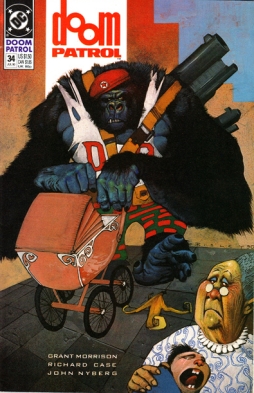 Yet for all the strangeness, the book worked because it was anchored in solidly-constructed characters. Some of the best issues, in fact, were single-issue character explorations — Dorothy coming to terms with her powers, puberty, and the end of childhood; Cliff entering Crazy Jane’s psyche to help her personae confront her memories of the father who had abused her as a little girl. But characters also lived in the offhand comment, the telling vignette. Cliff Steele’s situation had never been as well-dramatised as under Morrison; he had nightmares about his accident, he complained about the lack of detail in the sensory inputs of his robot body, he kept his own ashes in a vase. You could actually believe in this Robotman; he was quirky enough to be real. And because he was credible as a character, you related to the book, no matter how strange it got.
Yet for all the strangeness, the book worked because it was anchored in solidly-constructed characters. Some of the best issues, in fact, were single-issue character explorations — Dorothy coming to terms with her powers, puberty, and the end of childhood; Cliff entering Crazy Jane’s psyche to help her personae confront her memories of the father who had abused her as a little girl. But characters also lived in the offhand comment, the telling vignette. Cliff Steele’s situation had never been as well-dramatised as under Morrison; he had nightmares about his accident, he complained about the lack of detail in the sensory inputs of his robot body, he kept his own ashes in a vase. You could actually believe in this Robotman; he was quirky enough to be real. And because he was credible as a character, you related to the book, no matter how strange it got.
Richard Case’s blocky, design-oriented art helped the stories immeasurably. He was able to visualise any strangeness Morrison called for, and create a consistent yet strange world in which to situate them. His work didn’t have much of the kineticism of traditional super-heroes, but did have a quality of vision that made him a good fit for Doom Patrol. His characters were just this side of caricature, but there was something honest in their faces, and something quietly real in their body language.
It seemed at the time that Morrison was expressing a dissatisfaction with the limits of the mainstream; but there was also an obvious deep affection for the old heroes. It’s just that he wasn’t trying to rewrite previous stories. He was trying to do something new, in the spirit of their original tales, but taken that much further. He was very respectful of continuity; no characters had their history rewritten, though some events were seen from a new perspective. In a Comics Journal interview, he observed “it annoyed me the way people were saying ‘Superheroes are stupid.’ Well, they are stupid, but there was also a thing I pointed out, which is that Animal Man will be around when I’m dead. Their world functions within its own parameters, and it has its own rules.”
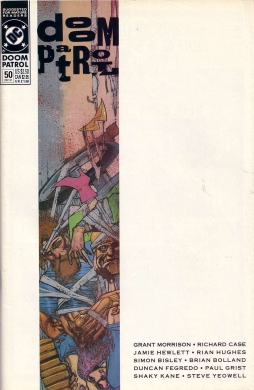 In the same interview, Morrison said of Doom Patrol that “people began to say it was pretentious, which baffled me because I thought it was just funny, and I thought it was basically just a superhero strip … there weren’t any secrets in it, nothing was symbolic in Doom Patrol.” You can see his point; the stories were simple, lean things, that happen to be told through occasionally-baroque devices. But then again, the plots weren’t always shaped like super-hero stories; punching the bad guy never really seemed to be the solution. In the American mainstream market, that made it intensely strange.
In the same interview, Morrison said of Doom Patrol that “people began to say it was pretentious, which baffled me because I thought it was just funny, and I thought it was basically just a superhero strip … there weren’t any secrets in it, nothing was symbolic in Doom Patrol.” You can see his point; the stories were simple, lean things, that happen to be told through occasionally-baroque devices. But then again, the plots weren’t always shaped like super-hero stories; punching the bad guy never really seemed to be the solution. In the American mainstream market, that made it intensely strange.
Can the book be said to have a meaning, even if Morrison swears he had nothing in particular on his mind? I think so; I think when a writer sits down and produces a long work, over a long time, something’s going to come out of it. I think Morrison juggled themes of significance to him, and I think you can see them in the book. There’s a fine overview of the series here (with many spoilers), arguing that the book’s about the conflict of creativity and mundanity. I think there’s an element of that, surely. I think also that the book’s about the construction of meaning, the need people have to find meaning in events, and how it is that they come to find it. And, in the end, in the climax of the run — for the whole set of stories has a shape to it — we find out it was also about catastrophe, about radical change, about disaster and moving on to a better world.
Morrison left the title after issue 63, but DC didn’t cancel the book. Instead, author Rachel Pollack took over, and Doom Patrol joined a number of artistically-ambitious titles that had emerged out of the mainstream in a separate imprint called Vertigo. Pollack’s Doom Patrol suffers from following Morrison; it suffers also from being too similar to his work. Many of the surface tics are there — semi-random dialogue, strangeness contrasting with the modern world — but with little of the subtlety or sense of character that Morrison had, so that the stories feel flat. That said, the pacing and storytelling is effective, if again resembling Morrison, and there are some nice ideas: a character offhandedly mentions a PAC for super-heroes, lobbying against government regulation on heroes. Pollack’s stories were informed by her own experience as a transsexual woman, and indeed there was a concrete yet inventive sexuality in her storylines that was distinctive. The tone shifted back and forth unpredictably, but often veered into the explicitly satirical.
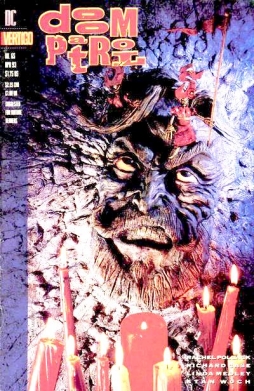 At the start of her run, though, too much seemed derived from Morrison’s work. More precisely, her writing seemed to be contained by Morrison’s ideas. It’s the curse of super-hero books; an innovative, transformative work rarely inspires equally innovative sequels. Mostly it just inspires reworkings of the no-longer-new material. But Pollack recovered from a shaky start, and when she was joined by artist Ted McKeever, produced a suprising run of mystical adventure; deeply symbolic fables which, if they never seemed to have the human spark of Morrison’s best work, nevertheless had a profundity and truth of their own.
At the start of her run, though, too much seemed derived from Morrison’s work. More precisely, her writing seemed to be contained by Morrison’s ideas. It’s the curse of super-hero books; an innovative, transformative work rarely inspires equally innovative sequels. Mostly it just inspires reworkings of the no-longer-new material. But Pollack recovered from a shaky start, and when she was joined by artist Ted McKeever, produced a suprising run of mystical adventure; deeply symbolic fables which, if they never seemed to have the human spark of Morrison’s best work, nevertheless had a profundity and truth of their own.
But the comics market is a fierce, sad thing. The book was cancelled with issue 87. Several attempts to reboot the series as a more-or-less-straight super-hero book have followed over the years, but none has really caught hold; the latest was cancelled only a couple of months ago. Inevitably, because this is mainstream comics, and corporations need to service their trademarks, the title will return again, sooner or later.
But when it does, will it have the sort of individual voice that’s made Doom Patrol stand out in the past? As a comics reader, this question worries me. Over the past couple of decades, the comics marketplace has narrowed — but, surprisingly, Morrison’s gone on to become one of the biggest-selling writers in modern comics; he wrote a well-regarded run on DC’s JLA, moved to Marvel to write X-Men for some years, then returned to DC where he now writes the main Batman book. Which is to say that Morrison’s moved from the fringe to the centre; his voice, once strange and peculiar, has helped shape current comics storytelling. That’s the importance of the fringe, of the weird: it’s a venue for new ideas, new voices, new ideas about voices, to enter. Without that fringe, how long can the centre last?
Matthew David Surridge is the author of “The Word of Azrael,” from Black Gate 14. His blog is Hochelaga Depicta.
Ah, the Brotherhood of Dada! They were especially wonderful villains. I’d forgotten them, but the journey through Crazy Jane’s mind has stuck with me quite vividly since the early 1990s.
My phase as a serious reader of comics began my freshman year of college, when my boyfriend said, “What do you mean, you’ve never heard of Alan Moore? We’ll have to fix that.” It ended when I graduated and had to pay all my own bills, though I did stick with Sandman to the end of its run. I get the impression I was the beneficiary of a golden age.